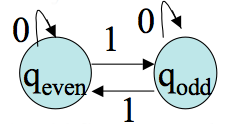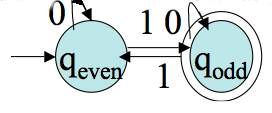










More Deterministic Finite Automata
CS154
Chris Pollett
Feb. 9, 2011











CS154
Chris Pollett
Feb. 9, 2011
At the end of Monday, we gave the following formal definition of deterministic finite automata (DFA):

public abstract class Automata
{
public Automata()
{
}
public void setState(int state)
{
currentState = state;
}
public boolean processString(String w)
{
for(int i = 0; i < w.length(); i++)
{
currentState = delta(currentState, w.charAt(i));
}
boolean accept = finalState(currentState);
return accept;
}
public abstract int delta(int state, char c);
public abstract boolean finalState(int state);
int currentState;
}
public class TestAutomata extends Automata
{
public TestAutomata()
{
}
public int delta(int state, char c)
{
int outState = 1;
switch(state)
{
case 1:
if(c == '0')
{
outState = 1;
}
else
{
outState = 2;
}
break;
case 2:
if(c == '0')
{
outState = 3;
}
else
{
outState = 2;
}
break;
case 3:
outState = 2;
break;
}
return outState;
}
public boolean finalState(int state)
{
return (state == 2) ? true : false;
}
public static void main(String args[])
{
TestAutomata test = new TestAutomata();
test.setState(1);
if(args.length == 0 ){
System.out.println("It is not recognized by this automata.");
}
System.out.println("Checking the string "+ args[0]);
if(test.processString(args[0]))
{
System.out.println("It is recognized by this automata.");
}
else
{
System.out.println("It is not recognized by this automata.");
}
}
}


Let `M= (Q, Sigma, delta, q0, F)` be a DFA, and GM be its associated transition graph. Then for every `q_i`, `q_j` in `Q` and `w` in `Sigma^star` , `delta^star(q_i,w) = q_j` iff there is in GM a walk with label `w` (that is, the edge labels written down as a string are `w`) from `q_i` to `q_j`.
Proof. We give a proof by induction on the length `n geq 0` of `w`. Notice `delta^star(q, epsilon)=q` corresponds exactly with a walk of length `0` in GM . So the `|w|=0` case holds. Assume the statement is true up to some `n`. Let `w=va` where `|v|=n`. (The induction step case.) Suppose `delta^star(q_i,v) = q_k` . By the induction hypothesis there is a walk `W` of length `n` in GM from `q_i`,to `q_k`. If `delta^star(q_i,w) = q_j` we must have `delta^star(q_i,w) = delta (delta^star(q_i,v), a) = q_j` by the definition of `delta^star.` So we have `delta(q_k,a) = q_j`. Thus, if we add to `W` the edge `(q_k, q_j)`, the label on the resulting walk will be `va=w` as desired. This new walk has length `n+1`. It is also not hard to turn this argument around to show if one stated with a walk of length `n+1` with label `w`, that one could show `delta^star(q_i,w) = q_j`. You should do this at home.